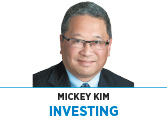Subscriber Benefit
As a subscriber you can listen to articles at work, in the car, or while you work out. Subscribe Now The rise in U.S. stocks was anything but a straight-line advance as they continued their roller-coaster ride in the second quarter of 2019. In April, stocks built on their first-quarter gains (the S&P 500 climbed back to its high reached in October 2018) but faltered sharply in May amid harsh rhetoric from the United States regarding trade with China and Mexico.
The rise in U.S. stocks was anything but a straight-line advance as they continued their roller-coaster ride in the second quarter of 2019. In April, stocks built on their first-quarter gains (the S&P 500 climbed back to its high reached in October 2018) but faltered sharply in May amid harsh rhetoric from the United States regarding trade with China and Mexico.
Fortunately, “dovish” comments from the Fed on interest-rate policy and indications of progress in easing trade tensions led the S&P 500 to its best June since 1955 and best first half since 1997.
What a difference six months makes! ’Twas the night before Christmas (2018) and the December stock price collapse reached a crescendo (DJIA -653.17 points) as investors seemed to lose their collective minds on fears of the Federal Reserve’s raising short-term interest rates too quickly and the on-again tariff spat with China escalating into a full-blown trade war.
Who could have guessed that, by the end of this June, the S&P 500 would be up more than 25% from that panic low and reach a record high on the Fed’s 180-degree shift, signaling future reductions in rates and a pause in the trade hostilities with China?
This is a great example of the benefit of being able to keep your head when all around you are losing theirs and the cost of not being able to do so. Remember that the more often you look, the more volatility you experience. So try to tune out the noise and stick with your long-term plan.
Bespoke Investment Group examined returns for second halves of calendar years following first halves when both stocks and long-term U.S. Treasury bonds returned more than 5%. Recall that during the bull market for U.S. stocks from the March 9, 2009, low, positive performance for stocks coincided with weaker performance for bonds and vice versa. When it was “risk-on” for investors, stocks gained and bonds dropped and when it was “risk-off,” the opposite occurred.
The double-digit returns for stocks and bonds in the first half of 2019 were an anomaly that has happened in only four other years since 1980. In fact, the S&P 500’s average second-half return following the nine first halves where both stocks and bonds were up over 5% was 11.3%, with positive returns in all but one (1986 was -1.79%). This was more than twice the average second-half return for all second halves since 1980.
Similarly, the investment firm CFRA said the strong first half bodes well for the second half, but with an important caveat. Since 1945, following first-half gains of 10% or more for the S&P 500, the second half rose an average of 7.5% and was up 80% of the time, as compared with an average gain of 4.1% and 69% up for all second halves.
CFRA’s Sam Stovall further noted that, while in 2019 the S&P 500 recorded its third-strongest year-to-date return through April since 1945, history warned May would likely be weak (it was) but June should rally (it did).
Examining returns for the remaining months following the previous five strongest starts to the year, the S&P 500 fell an average 5.2% in the July-through-October period and declined in price 80% of the time. While history suggests the road is likely to get increasingly bumpy over the next four months, it will be important (as always) to try to remain unemotional and stick with the plan. Indeed, stocks traditionally regained their footing in the final two months of the year.
For the five strongest starts, the S&P 500 gained an average of 3.1% during November-December and advanced 80% of the time.
June and the first half of 2019 were terrific. While the fundamentals underpinning the stock market’s recent advance are still good, risks related to China/global trade, Iran, North Korea and a host of other topics, known and unknown, remain elevated. We’re not predicting a sequel to the Christmas Eve Massacre, but it’s best to remember stock prices are inherently volatile, and scary downdrafts can occur at any time for any or no reason at all.
Indeed, in just the past 18 months, U.S. stocks experienced a correction at the beginning of 2018, a near-bear market in late 2018 and an ugly May 2019. In addition, according to Stovall, the third quarter is “notorious for delivering the weakest average price return, while recording the deepest decline and greatest volatility.”•
__________
This column was excerpted from Kirr Marbach & Co.’s second-quarter client letter, available at www.kirrmar.com. Kim is the chief operating officer and chief compliance officer for the firm. He can be reached at 812-376-9444 or [email protected].
Please enable JavaScript to view this content.
